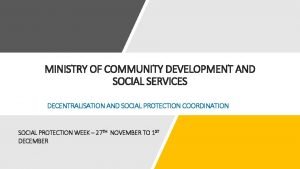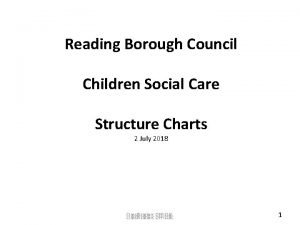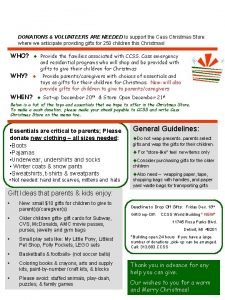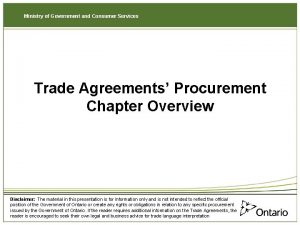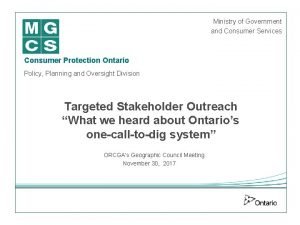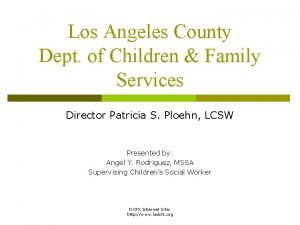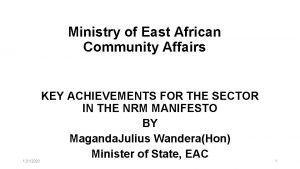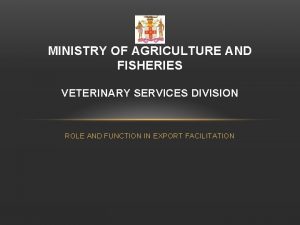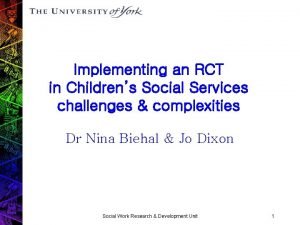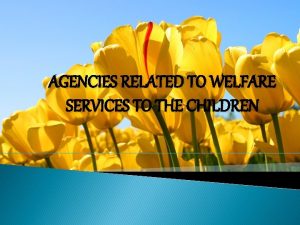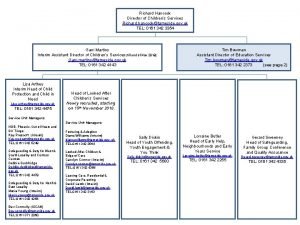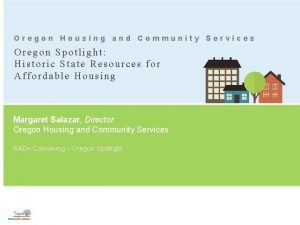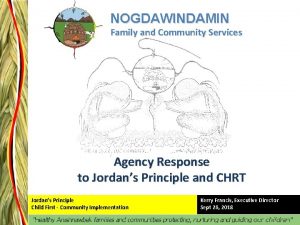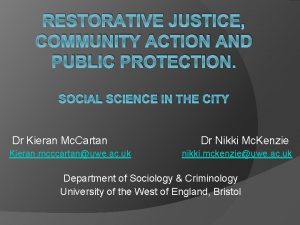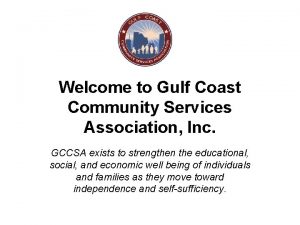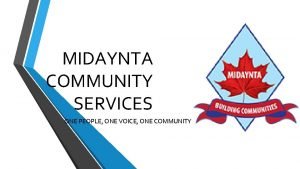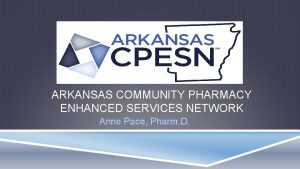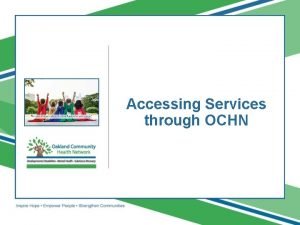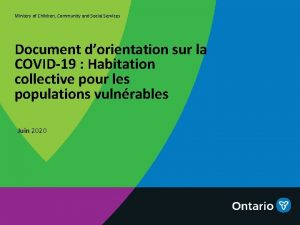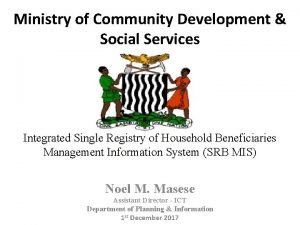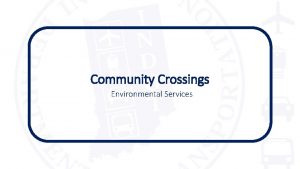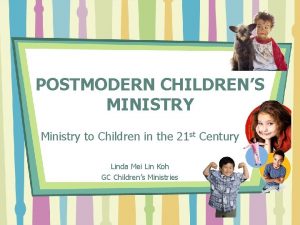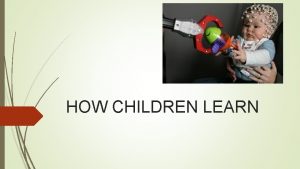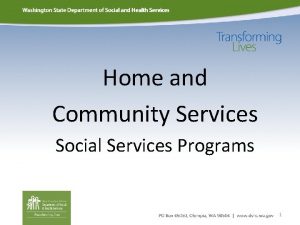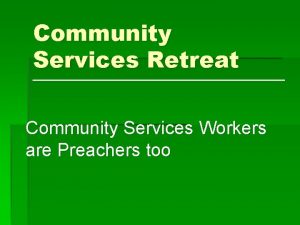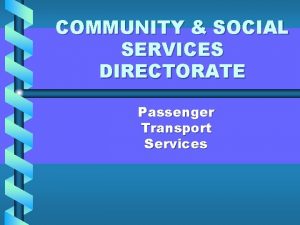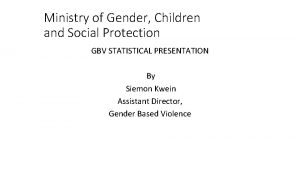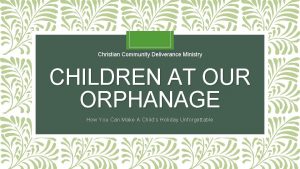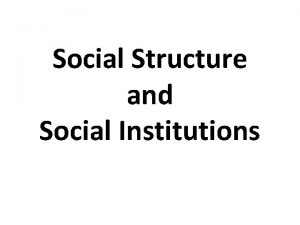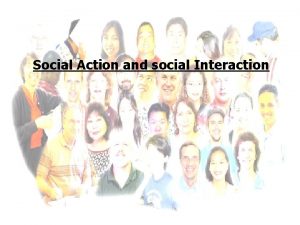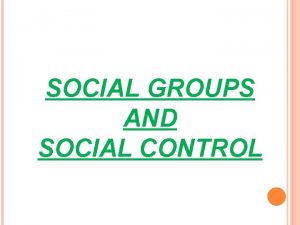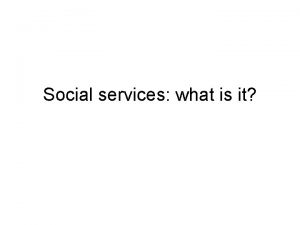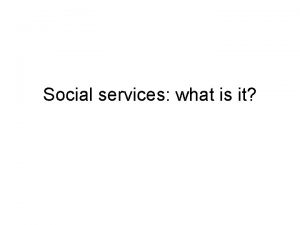Ministry of Children Community and Social Services Ministry






























- Slides: 30

Ministry of Children, Community and Social Services Ministry of Health COVID-19 Guidance: Congregate Living for Vulnerable Populations June 2020

Overview 01 Context and What’s New § § § 02 03 04 05 2 Protecting Vulnerable Ontarians: COVID-19 Action Plan for Vulnerable People COVID-19 Guidance: Congregate Living for Vulnerable Populations Application of the Guidance to Ministry of Children, Community and Social Services (MCCSS) Settings MCCSS COVID-19 Response Management Activities Overview of Guidance & Operational Direction Questions Appendix COVID-19 Guidance: Congregate Living for Vulnerable Populations Low sensitivity

Protecting Vulnerable Ontarians: COVID-19 Action Plan for Vulnerable People On April 23, 2020, the government announced the COVID-19 Action Plan for Vulnerable People (Action Plan) to better protect those living in high risk setting residential settings, including Indigenous residential settings on and off reserve. 01 Prevention – Enhanced Screening and Reduced Exposure to Prevent Spread § Consistently apply Public Health guidance § Enhanced screening § Restrict visitors § Use of surgical masks (subject to risk/availability) § Limit staff mobility § Staff training 3 COVID-19 Guidance: Congregate Living for Vulnerable Populations 02 Infection Control – Managing Outbreaks and Limiting Spread § Enhance testing § Contact tracing § Restrict staff to work at a single location § Mandatory use of surgical masks/PPE during an outbreak § Enhanced guidance on PPE usage and conservation § Enhanced training for staff on outbreak protocols § Provide alternate sites for congregate living Low sensitivity 03 Sustaining Existing Staff and Managing Critical Staff Shortages § Leverage community agency capacity § Wage premium

COVID-19 Guidance: Congregate Living for Vulnerable Populations As part of the government’s ongoing activities to support the Action Plan, the Ministry of Health (MOH) has released new COVID-19 Guidance: Congregate Living for Vulnerable Populations. The guidance provides recommendations and actions to help protect vulnerable populations and staff in congregate settings from COVID-19, and reflects the current best advice from MOH and Public Health Ontario (PHO). This guidance replaces previous guidance and direction issued, including: § Guidance for Group Homes and Co-Living Settings and Guidance for Homeless Shelters (April 1) § Guidance for Community-Based Mental Health and Addictions Service Providers in Residential Settings (April 17) § Ministry of Children, Community and Social Services (MCCSS) memos to Developmental Services, Violence Against Women, Anti-human Trafficking, Intervenor and Indigenous Healing and Wellness Strategy Residential Agencies (April 27) § MCCSS memo to Children’s Residential Service Providers (May 8) 4 COVID-19 Guidance: Congregate Living for Vulnerable Populations Low sensitivity

Requirements under the Congregate Care Settings Emergency Order The congregate care settings emergency order (O. Reg. 177/20) filed on April 24, 2020, under the Emergency Management and Civil Protection Act was renewed on May 26, 2020 and remains in effect. Under s. 9 of this emergency order, all developmental services, violence against women, anti-human trafficking and intervenor settings covered by the regulation must follow the COVID-19 Guidance: Congregate Living for Vulnerable Populations. Although the emergency order does not apply to children’s residential, child welfare, and youth justice settings, and programs under the Indigenous Healing and Wellness Strategy, they are strongly encouraged to review and follow the guidance, and implement operational direction applicable to their settings. 5 COVID-19 Guidance: Congregate Living for Vulnerable Populations Low sensitivity

What’s New § Definitions to guide operational consideration (e. g. physical distancing, hand hygiene) § Consistent approach to engaging with, and seeking advice from, local public health units 6 § New guidance advising routine use of masks by staff and essential visitors to protect others (source control) § More guidance for active and passive screening of staff, essential visitors and residents § Emphasis on physical distancing to prevent transmission, with guidance, advice and recommendations to achieve physical distancing § Expanded guidance for caring for residents who need to self-isolate § New guidance for selecting appropriate personal protective equipment (PPE) § New guidance on addressing new admissions and transfers § New guidance for outbreak management, including direction and support that can be expected from public health units COVID-19 Guidance: Congregate Living for Vulnerable Populations Low sensitivity

MCCSS COVID-19 Response Management Activities 01 02 03 7 Hierarchy of Controls Management and Distribution of PPE Risk Management Approach COVID-19 Guidance: Congregate Living for Vulnerable Populations Low sensitivity

Hierarchy of Controls As the province reopens, ensuring optimal alignment and clarity of guidelines related to the hierarchy of controls, including the appropriate use and conservation of PPE, will be a vital mechanism for managing the anticipated increase in demand continued constraints on PPE supply across the system. National Institute of Occupational Safety and Health Hierarchy of Controls Elimination Remove the hazard Substitution Replace the hazard Engineering Isolate people from the hazard Administrative Process PPE 8 Social Sector Implementation - Examples • Plexiglass shields at ODSP and FRO counters • Distancing measures at facilities; cohorting • Hand washing and hygiene measures • Resident admission rules, staffing changes, screening • Training, signage Change behaviour Use personal protective equipment COVID-19 Guidance: Congregate Living for Vulnerable Populations • Virtual approaches (e. g. , risk assessments; diagnostic assessments; counselling) • Closure of day programs and community activities • Work from home Low sensitivity • Providing TPR staff and Ministry staff with appropriate PPE based on guidelines and occupation

Guiding Principles for Distribution of PPE Topic: The following are the guiding principles by which the ministry is managing the distribution of PPE supplies across the sector: Maintenance of Sector Inventory Understanding the supply and demand across the sector using the weekly CSE survey and maintaining consistent inventory of supplies to meet Public Health standards. Proactive Response PPE supplies are provided to all essential front-line staff proactively to reduce outbreaks and the spread of COVID-19 through cyclical weekly top-up, ad hoc order and emergency response order processes. Centralized Distribution Established a central supply source, to meet the direct needs of the MCCSS sectors and ensure that both preventative and reactive demands are actioned appropriately and are responsive to the specific needs of the social sector. Supply Levels Maintain a minimum two-week supply of medical PPE inventory in the social services sector (assuming ongoing supply), with an emergency backstop supply capable of supporting outbreak requirements. 9 COVID-19 Guidance: Congregate Living for Vulnerable Populations Low sensitivity

Allocation, Supply and Distribution Process 4. Local Distribution 3. Social Sector Warehouse Supply 1. CSE Survey 2. Non. Health Allocation 10 COVID-19 Guidance: Congregate Living for Vulnerable Populations 1. CRITICAL SUPPLIES AND EQUIPMENT (CSE) SURVEY § Non-Health weekly survey distributed to all service providers every Thursday; submissions are due by 5 pm the following Monday § Data in the survey reflects inventory provided by government supply chain and agency-sourced supply 2. NON-HEALTH ALLOCATION § Based on survey results and the demand model ministry allocations are determined by the COVID-19 Command Table § Survey results indicate the level of supply available in the sector and the weekly demand 3. SOCIAL SECTOR WAREHOUSE SUPPLY § Allocations identified at Command Table are delivered to the social sector centralized warehouse § PPE is distributed in coordination with the ministry based on needs identified through the CSE survey 4. LOCAL DISTRIBUTION § All regular shipments are processed within 24 to 48 hours § Emergency orders and orders for agencies with outbreaks are processed and shipped within 24 hours § Distribution of supplies is province-wide Low sensitivity

Warehouse Supply and Distribution • Sector warehouse supply includes government PPE supplies purchased from multiple sources. • Sector warehouse capacity is continuously expanding to include new classes of PPE including cloth masks to support the reopening of the province. PPE CATEGORY SOCIAL SECTOR WAREHOUSE AVAILABILITY (MAY 29) NOTES Gloves 600, 000+ Nitrile S/M/L/XL Surgical Masks 600, 000+ Level 1 and Pediatric Gowns 10, 000+ Disposable Hand Sanitizer 80, 000+ 0 -999 ml bottles Face Shields 30, 000+ Disposable Disinfectant Wipes 40, 000+ Antiseptic Wipes Other PPE 1, 400+ Safety Glasses, Booties and Thermometers 11 COVID-19 Guidance: Congregate Living for Vulnerable Populations Low sensitivity

Residential Risk Assessment for Congregate Settings To support and address objectives of the COVID-19 Action Plan for Vulnerable People, targeted outreach activities are occurring with residential service providers that are tailored to support the following: Identify situations where there are increased risks contributing to or resulting from an COVID-19 outbreak Using available mechanisms, continue to engage on prevention, outbreak management and resources. Action/Intervention to prevent and/or mitigate the impact of potential COVID 19 outbreaks. This includes efforts related to: § Prevention – enhanced screening and reduced exposure to prevent spread § Infection control – managing outbreaks and limiting spread § Sustaining existing staff and managing critical staff shortages 12 COVID-19 Guidance: Congregate Living for Vulnerable Populations Low sensitivity

Linkages and Next Steps § The Risk Assessment process has : § Created a structure for ongoing and collaborative discussions between the ministry and agencies about managing risk on an ongoing basis § Positioned us to be prepared for subsequent waves of outbreak § Ministry program staff will continue to engage with agencies to assist with any resources that may help to support mitigation of vulnerabilities. (eg. accessing local public health unit resources and capacity for assistance in Infection Prevention and Control or outbreak management planning activities) § Outreach activities have taken place for Developmental Services, Violence Against Women, Anti-Human Trafficking and Intervenor Services transfer payment recipients. Children’s Residential Risk Assessment is also in development. 13 COVID-19 Guidance: Congregate Living for Vulnerable Populations Low sensitivity

Review of Guidance and MCCSS Operational Direction 01 02 03 04 05 06 07 14 General Advice and Planning Activities Prevention of Disease Transmission Screening Caring for Residents that Need to Self-Isolate Reporting Outbreak Management Occupational Health and Safety COVID-19 Guidance: Congregate Living for Vulnerable Populations Low sensitivity

01. General Advice and Planning Activities MOH GUIDANCE § Review services and operations to identify ways to reduce the risk of exposure to COVID-19 § Policies and procedures related to outbreak management should be in place, reviewed, communicated and updated regularly MCCSS OPERATIONAL DIRECTION § Review the Outbreak Management section of the COVID-19 Guidance: Congregate Living Settings and update your organization’s outbreak plan accordingly, working with bargaining agents where appropriate § MCCSS’ Directly Operated Facilities and funded agencies participate in the Ontario Government’s mandatory Critical Supplies and Equipment (CSE) § Education, instruction and training Non-Health Survey to inform the Government on about disease transmission and your current inventory of PPE and to determine prevention reviewed regularly with the demand across the sector residents, staff and essential visitors § Organizations must complete this survey § A training program to support the safe every week to receive supply from the implementation of recommended Ontario Government precautions § The survey must also be completed to § Procedures in place to transfer the receive reimbursement through the COVIDcare of a resident, if at any time they 19 Resident Relief Fund for the costs of PPE are unable to safely support that acquired outside the CSE resident because of COVID-19 Guidance: Congregate 15 Living for Vulnerable Populations Low sensitivity

02. Prevention of Disease Transmission MOH GUIDANCE Prevent/limit the spread of COVID-19 through: Visitors: Limit non-essential visitors into congregate living settings to reduce risk (see Visitors Guidance for outdoor visits ) Hand hygiene: Frequent hand washing, or hand sanitizing, to maintain clean hands and fingernails Physical distancing: a minimum of 2 metres or 6 feet from other individuals (including shared bedrooms) and limiting activities outside the congregate living setting MCCSS OPERATIONAL DIRECTION An ESSENTIAL VISITOR is generally a person (including a contractor) who performs essential services to support the ongoing operation of a service agency or is a person considered necessary by a service agency to maintain the health, wellness and safety, or any applicable legal rights, of a resident § Limit entry to staff and essential visitors, and maintain a log of the entry of essential visitors § Different family units within a setting must keep a distance of at least 2 metres from other family units, to the extent possible Cleaning and disinfecting: all high-touch surfaces should be cleaned and disinfected at least twice a day and when visibly dirty 16 COVID-19 Guidance: Congregate Living for Vulnerable Populations Low sensitivity

02. Prevention of Disease Transmission (Visitors) MCCSS GUIDANCE AND OPERATIONAL DIRECTION § Visits may occur with non-essential visitors in outdoor spaces, where there is sufficient staff capacity to support the visits § If a setting is in an outbreak situation, outdoor visits must be suspended until the local public health unit has declared it resolves § Agencies should have a clear process for communicating with residents, families and staff about visits, including: § Scheduling visits, including number of visitors, length § Screening visitors, including written documentation demonstrating that the visitors have tested negative for COVID-19 in the previous 2 weeks and subsequently not tested positive § Maintaining proper hand hygiene, physical distancing and masking § Handling of gifts shared during visits, including sanitizing prior to sharing § Consequences of non-adherence with the policies and procedures § These changes do not apply to the youth justice sector at this time 17 COVID-19 Guidance: Congregate Living for Vulnerable Populations Low sensitivity

02. Prevention of Disease Transmission (Masking) MOH GUIDANCE Prevent and limit the spread of COVID-19 through: Routine masking: § recommended that all staff and essential visitors wear non-medical masks when in the congregate living setting for the duration of their shifts or visits § residents may choose to wear nonmedical masks or be encouraged to do so Masking while providing direct resident care: § the need for PPE should be assessed based on the type of interaction 18 COVID-19 Guidance: Congregate Living for Vulnerable Populations MCCSS OPERATIONAL DIRECTION § All staff and essential visitors MUST wear masks for source control AT ALL TIMES while in the setting § Non-medical masks (e. g. cloth masks) are appropriate equipment for source control, but are not considered PPE § Non-medical masks are an excellent way to achieve source protection while conserving medical PPE § If non-medical masks are not available, medical masks can be used § Staff may remove their mask during breaks but must remain two metres away from other staff Low sensitivity

03. Screening (Entry) MOH GUIDANCE Screening activities § Establish a formal process for screening staff and essential visitors § Staff and essential visitors who do not pass the screening should not be permitted to enter the congregate living setting § Residents who do not pass the screening should self-isolate and wait for assessment New admissions and transfers § Where possible, new admissions or transfers should be screened and tested for COVID-19 prior to arrival MCCSS OPERATIONAL DIRECTION § Do not accept new admissions/readmissions during an outbreak § Make limited exceptions: § where the safety is at risk § no alternative available § new admission is mandatory § Decisions on new admissions or transfer should be made with the advice of the local public health unit § Plans and processes should be in place to support residents who are self-isolating § New residents should self-isolate for a period of 14 days upon arrival 19 COVID-19 Guidance: Congregate Living for Vulnerable Populations Low sensitivity

03. Screening MOH GUIDANCE Daily screenings § Residents, staff and essential visitors should be screened twice daily for COVID-19 signs and symptoms § Staff and essential visitors should be screened at the start and end of each shift or visit Positive screenings § If a resident develops signs and symptoms, they should be placed in a single room with a door that closes § If staff or an essential visitor develops signs or symptoms, they should tell their supervisor immediately and separate themselves from others, and contact their primary care provider or Telehealth Ontario 20 COVID-19 Guidance: Congregate Living for Vulnerable Populations MCCSS OPERATIONAL DIRECTION § Screen residents, essential visitors and staff twice per day for symptoms, including fever § Residents and staff who do not pass this screen should be treated as though they may have COVID-19 § Suspected or confirmed cases of COVID-19 among staff, essential visitors or residents are serious occurrences and are required to be reported both to MCCSS and your local public health unit Low sensitivity

04. Caring for Residents that Need to Self Isolate MOH GUIDANCE MCCSS OPERATIONAL DIRECTION Self-isolation § Isolate any residents who are showing signs § Residents should self-isolate if they and symptoms of COVID-19 and/or who are feel unwell, are awaiting test results, awaiting test results or have tested positive for COVID-19 § Testing should be facilitated for any resident Maintaining physical distance who is symptomatic § Residents may be grouped with others who are in the same situation as them, if there is not enough space to selfisolate § Where residents are grouped, maintain as much distance as possible from other individuals of groups Providing direct care § Staff providing direct care should take appropriate precautions depending on the nature of the planned interaction and what is known about the health status of the resident 21 COVID-19 Guidance: Congregate Living for Vulnerable Populations Low sensitivity

05. Reporting MOH GUIDANCE MCCSS OPERATIONAL DIRECTION § Where you become aware that a resident, staff or Duty to report essential visitor has or may have COVID-19: § Contact your local public health unit to § COVID-19 is designated as a disease of facilitate timely outbreak management public health significance and § Advise your MCCSS program supervisor reportable under the Health § Complete a Serious Occurrence Report Protection and Promotion Act § Isolate any residents who are showing signs and Contacting public health symptoms of COVID-19 and/or who are awaiting § Work with the local public health unit test results to facilitate timely contact tracing and § When a staff member has/may have COVID-19, they outbreak management must tell their supervisor, go home and contact § Indicate the type of care setting to assist with public health tracking of cases 22 COVID-19 Guidance: Congregate Living for Vulnerable Populations their primary care provider or Telehealth Ontario § If an employer is advised that a worker has an illness due to exposure in the workplace, employer must notify the Ministry of Labour, Training and Skills Development in writing within four days Low sensitivity

06. Outbreak Management MOH GUIDANCE Declaring an outbreak § An outbreak is one laboratory confirmed case in a resident or staff § Outbreaks are declared by the local medical officer of health or their designate in coordination with the administrator § In an outbreak situation, the local public health unit will direct testing and public health management of residents § Residents and agencies should be notified about the outbreak and outbreak measures being implemented 23 COVID-19 Guidance: Congregate Living for Vulnerable Populations MCCSS OPERATIONAL DIRECTION § Continue rigorous physical distancing, hand hygiene, and respiratory etiquette § Under O. Reg 177/20, exposed staff in applicable settings may only work at a single site where an outbreak occurs § MCCSS’ Directly Operated Facilities and funded agencies participate in the Ontario Government’s mandatory Critical Supplies and Equipment (CSE) Non-Health Survey to inform the government on your current inventory of PPE and to determine the demand across the sector Low sensitivity

06. Outbreak Management (Control Measures) MOH GUIDANCE Control measures § Control Measures: action or activity that can be used to prevent, eliminate or reduce a hazard § The local public health unit will provide direction to help manage the outbreak and control measures that can be implemented Declaring an outbreak over § The local medical officer of health or their designate will declare when the outbreak is over § Generally, an outbreak is declared over when there are no new cases of COVID -19 in residents or staff after 14 days 24 COVID-19 Guidance: Congregate Living for Vulnerable Populations MCCSS OPERATIONAL DIRECTION § The local public health unit may provide specific guidance and direction for outbreak management, including: § defining the outbreak area (entire facility vs an affected unit or floor) § enhanced cleaning § isolation of positive cases and cohorting ill residents together and well residents together, and the staff who support them, including whether any residents should be re-located § enhanced screening or monitoring needed § guidance on how to implement infection prevention and control (IPAC) measures Low sensitivity

06. Outbreak Management (Use of PPE) MOH GUIDANCE Personal protective equipment MCCSS OPERATIONAL DIRECTION § The use and type of PPE changes when in an active outbreak situation § Appropriate PPE is based on the nature of the patient interaction – resources § When working directly and in close contact with on the recommended PPE and their those with symptoms or a confirmed COVID-19 use, including an outbreak, is available cases, Droplet and Contact Precautions are through Public Health Ontario required, which includes the following PPE: § Staff should wear a medical § gloves (surgical/procedure) mask, eye § gown protection and gown when in the § surgical masks outbreak area where resident § eye protection (goggles or face shields). interactions are possible; gloves are used when providing direct care and § Aerosol-generating medical procedures should hand hygiene performed when be performed by trained staff members, using removed an N 95 respirator § An N 95 respirator is only required if an § Staff should be fit tested and trained on the aerosol-generating medical procedure appropriate use and care of N 95 respirators is being performed 25 COVID-19 Guidance: Congregate Living for Vulnerable Populations Low sensitivity

07. Occupational Health and Safety MOH GUIDANCE Health and Safety of Workers § Employers have legal duties to protect the health and safety of workers, under the Occupational Health and Safety Act Policies for Non-Medical Masks § Policies for use of non-medical masks should consider occupational requirements and the workspace configuration MCCSS OPERATIONAL DIRECTION § It is the employer’s responsibility to ensure all staff and essential visitors are instructed and trained on the safe use, limitations, conservation, as well as proper maintenance and storage of all supplies and equipment, including PPE Return to Work § Should be determined by the individual, in consultation with their healthcare provider and local public health unit § Health and safety guidelines are available through MOH and Ministry of Labour, Training and Skills Development 26 COVID-19 Guidance: Congregate Living for Vulnerable Populations Low sensitivity

Communications to Sectors and Next Steps MOH issued this guidance on May 28, 2020. MCCSS released communications to service providers and bargaining agents on June 2, 2020, including: § Memo § Important Direction to Follow (To Know/To Do) MOH shared MCCSS communication and operational guidance with local public health units on June 6, 2020. 27 COVID-19 Guidance: Congregate Living for Vulnerable Populations Low sensitivity

Questions? 28 COVID-19 Guidance: Congregate Living for Vulnerable Populations Low sensitivity

Appendices 01 29 Additional Resources COVID-19 Guidance: Congregate Living for Vulnerable Populations Low sensitivity

Additional Resources Government of Ontario Public Health Ontario COVID-19 Action Plan for Vulnerable Ontarians COVID-19 Preparedness and Prevention in Congregate Living Settings COVID-19 Self-Assessment Managing COVID-19 Outbreaks in Congregate Living Settings Ministry of Health COVID-19 Guidance: Congregate Living for Vulnerable Populations COVID-19 Guidance for the Health Sector, including: § COVID-19 Reference Document for Symptoms § COVID-19 Provincial Testing Guidance Update § COVID-19 Patient Screening Guidance Document 30 COVID-19 Guidance: Congregate Living for Vulnerable Populations Congregate Living Setting Resources Toolkit Fact Sheets, including: § How to Self-Monitor § COVID-19 Non-Medical Masks and Face Coverings COVID-19 Health Care Resources, including: § Infection Prevention and Control Requirements for Aerosol-Generating Medical Procedures § Public health unit locator Low sensitivity
 Ministry of community development
Ministry of community development Reading borough council children's social services
Reading borough council children's social services Wake county human services community services center
Wake county human services community services center Cass community social services
Cass community social services Ministry of government and consumer services
Ministry of government and consumer services Ministry of government and consumer services
Ministry of government and consumer services Children and family services los angeles
Children and family services los angeles Ministry of east african community affairs uganda
Ministry of east african community affairs uganda Veterinary services division
Veterinary services division Rct children's services
Rct children's services Eyfs moodle hampshire
Eyfs moodle hampshire Child welfare services and agencies
Child welfare services and agencies Agencies related to welfare services to the children
Agencies related to welfare services to the children Lisa arthey children's services
Lisa arthey children's services Lorain county children services
Lorain county children services Social thinking and social influence in psychology
Social thinking and social influence in psychology Social thinking social influence social relations
Social thinking social influence social relations Oregon housing and community services
Oregon housing and community services Nogdawindamin meaning
Nogdawindamin meaning Community action cycle for community mobilization
Community action cycle for community mobilization Restorative justice community action
Restorative justice community action Social darwinism vs social gospel answer key
Social darwinism vs social gospel answer key Mmmmmmmmmmmmmmmmmmmmm
Mmmmmmmmmmmmmmmmmmmmm Midaynta community services islington
Midaynta community services islington Cpesn pharmacy locator
Cpesn pharmacy locator Oakland county health network
Oakland county health network City of temecula community services
City of temecula community services Hnncsb jobs
Hnncsb jobs Type of community pharmacy
Type of community pharmacy Ndsu community counseling center
Ndsu community counseling center Disha moses
Disha moses
